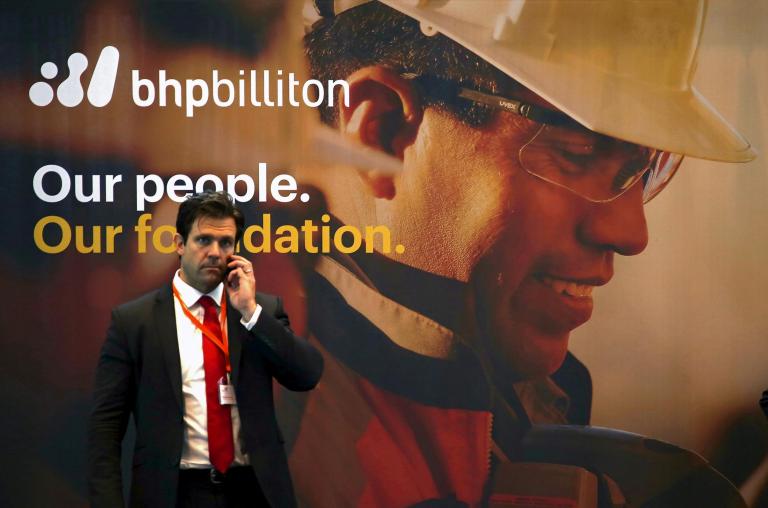This website uses cookies so that we can provide you with the best user experience possible. Cookie information is stored in your browser and performs functions such as recognising you when you return to our website and helping our team to understand which sections of the website you find most interesting and useful.

Mining giant BHP has warned that smoke and dust from Australia’s deadly wildfires is hurting coal production.
The world’s biggest mining company said production had slumped 11 per cent at its New South Wales coal mine and power station in the second half of last year, partly due to poor air quality resulting from Australia’s catastrophic bushfire season.
“Smoke from regional bushfires and dust have reduced air quality at our operations, which has impacted December 2019 production,” BHP said in a trading update on Tuesday.
“If air quality continues to deteriorate then operations could be constrained further” in the first six months of this year, the company added.
Some were quick to highlight BHP’s own contribution to the climate crisis.
Created with Sketch.
Created with Sketch.
1/20
A child running towards a dust storm in Mullengudgery in New South Wales
Marcia Macmillan/AFP
2/20
Wind gusts of 66 mph were recorded as a dust storm descended over Dubbo. Storms hit many parts of Australia's western New South Wales
Ian Harris via AP
3/20
Hail covers vehicles in an intersection in Canberra. As well as dust storms, hail and flash floods have battered beleaguered Australian cities as extreme weather has diminished the threat from scores of wildfires that continue to blaze across the country's southeast
Australia Institute via AP
4/20
A dust cloud billows over a street in Dubbo
Ian Harris via AP
5/20
A man holds golf ball-size hail outside Parliament House after a severe hail storm hit Canberra
EPA
6/20
A koala holding on to a tree before it was moved to a dryer enclosure during a flash-flood at the Australian Reptile Park in Somersby
Australian Reptile Park/EPA
7/20
Bushland is seen burnt by fire as rain pools in large puddles at Bilpin, in the Blue Mountains
AAP Image/Reuters
8/20
A staff member carrying koalas during a flash flood at the Australian Reptile Park
Australian Reptile Park/AFP
9/20
A dust storm in Mullengudgery
Marcia Macmillan/AFP
10/20
A submerged car on Gold Coast
AP
11/20
Damaged cars parked outside the National Film and Sound Archive of Australia after a hail storm hit Canberra
EPA
12/20
Golf ball-sized hail at Parliament House
Getty Images
13/20
Aftermath of a hail storm at the Commonwealth Scientific and Industrial Research Organisation (CSIRO) glasshouses in Canberra
EPA
14/20
A fallen tree sits on top of a car at Caringbah in Sydney. Storms in New South Wales left more than 2,200 homes without power
EPA
15/20
Damage at the Commonwealth Scientific and Industrial Research Organisation (CSIRO) glasshouses in Canberra
EPA
16/20
Hail stones outside the Parliament House in Canberra
Don Arthur/AFP
17/20
Storm clouds gather over Sydney Harbour
AFP via Getty
18/20
Hail covers vehicles in Canberra
AP
19/20
Flooded fields on Gold Coast
AP
20/20
An aerial view as rain begins to fall on drought and fire-ravaged country near Tamworth
Getty Images
1/20
A child running towards a dust storm in Mullengudgery in New South Wales
Marcia Macmillan/AFP
2/20
Wind gusts of 66 mph were recorded as a dust storm descended over Dubbo. Storms hit many parts of Australia's western New South Wales
Ian Harris via AP
3/20
Hail covers vehicles in an intersection in Canberra. As well as dust storms, hail and flash floods have battered beleaguered Australian cities as extreme weather has diminished the threat from scores of wildfires that continue to blaze across the country's southeast
Australia Institute via AP
4/20
A dust cloud billows over a street in Dubbo
Ian Harris via AP
5/20
A man holds golf ball-size hail outside Parliament House after a severe hail storm hit Canberra
EPA
6/20
A koala holding on to a tree before it was moved to a dryer enclosure during a flash-flood at the Australian Reptile Park in Somersby
Australian Reptile Park/EPA
7/20
Bushland is seen burnt by fire as rain pools in large puddles at Bilpin, in the Blue Mountains
AAP Image/Reuters
8/20
A staff member carrying koalas during a flash flood at the Australian Reptile Park
Australian Reptile Park/AFP
9/20
A dust storm in Mullengudgery
Marcia Macmillan/AFP
10/20
A submerged car on Gold Coast
AP
11/20
Damaged cars parked outside the National Film and Sound Archive of Australia after a hail storm hit Canberra
EPA
12/20
Golf ball-sized hail at Parliament House
Getty Images
13/20
Aftermath of a hail storm at the Commonwealth Scientific and Industrial Research Organisation (CSIRO) glasshouses in Canberra
EPA
14/20
A fallen tree sits on top of a car at Caringbah in Sydney. Storms in New South Wales left more than 2,200 homes without power
EPA
15/20
Damage at the Commonwealth Scientific and Industrial Research Organisation (CSIRO) glasshouses in Canberra
EPA
16/20
Hail stones outside the Parliament House in Canberra
Don Arthur/AFP
17/20
Storm clouds gather over Sydney Harbour
AFP via Getty
18/20
Hail covers vehicles in Canberra
AP
19/20
Flooded fields on Gold Coast
AP
20/20
An aerial view as rain begins to fall on drought and fire-ravaged country near Tamworth
Getty Images
Australian actor Terry Serio tweeted: “You Can’t Make This Stuff Up! Coal production down because of air quality as the result of #AustraliaFires”.
BHP has come under increasing scrutiny for its contribution to climate change. According to CDP, a nonprofit focusing on climate change research, BHP is one of the top 20 greenhouse gas producers since 1988. It is also the largest producer of coking coal, used in industrial processes including steel production.
Mel Evans, fossil fuel campaigner for Greenpeace UK, said the crisis should have given BHP pause for thought. “They could have looked at the bushfires, changed tack and warned investors of the dangers of coal.
“Instead they’ve chosen to lament the fact they can’t keep fuelling the climate emergency as quickly as they’d like. You couldn’t find a more damning indictment of the fossil fuel industry.”
BHP’s announcement came as Australian authorities warned that hazardous conditions could resume in the next few days now that a brief period of torrential rain and flash flooding has ended.
Temperatures were forecast to rise in inland parts of Victoria state and neighbouring South Australia on Wednesday.
The hotter temperatures, combined with strong winds, will potentially fan existing bushfires, leading officials to declare “extreme fire danger” in some areas.
“Tomorrow is real for us, extremely real,” Victorian emergency management commissioner Andrew Crisp told reporters in Melbourne.
Since September, 29 people have been killed by the fires and an area one-third the size of Germany has been destroyed. It follows three years of drought that experts have linked to climate change.
Rachel Kennerley, climate campaigner at Friends of the Earth, said: “Fossil fuel companies wilfully ignored the climate crisis for decades, but perhaps having production impacted by bushfire smoke will finally hit home how important it is that we stop burning fossil fuels.
“The Australian government needs to do more to fight the climate crisis but here in the UK we need our own government to start matching words with actions.
“UK ministers talk up our alleged global leadership role in moving past coal, but what’s being done at home must align with what’s being said internationally. This means that there can be no approval for new coal mines in the UK.”



 Africana55 Radio
Africana55 Radio 

